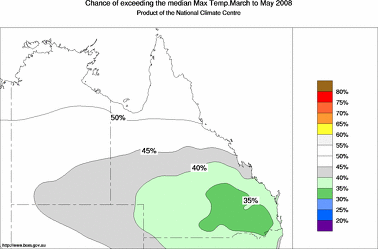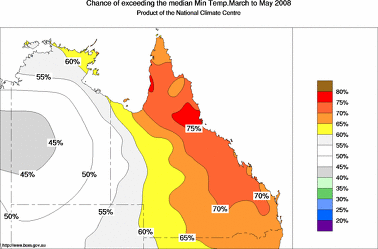|
The pattern of seasonal maximum temperature odds across northeastern Australia is a result of
the combined effects from above average temperatures in the central to southeast
Indian Ocean, and the cooler than average temperatures in the equatorial Pacific
(La Niña).
Averaged over March to May, the chances are between 30 to 40% for above-normal maximum
temperatures over the southern half of Queensland (see map).
This means that below-normal maximum temperatures have a 60 to 70% chance of occurring.
So for every ten years with ocean patterns like the current, about six or seven
autumns are expected to be cooler than average over these parts of northeastern Australia, with about
three or four being warmer. Elsewhere the odds are generally between
45 and 55% of exceeding the seasonal median. So the chances of being warmer than normal
are about the same as the chances of being cooler.
Outlook confidence is related to how consistently the Pacific and Indian
Oceans affect Australian temperatures. During autumn, history shows this
effect on maximum temperatures
to be moderately consistent over much of Queensland and the NT, apart from the
southwestern corners in each State where it is only weakly or very weakly
consistent (see background information).
In contrast, minimum temperatures averaged over autumn are favoured to be warmer than normal across
most of Queensland (see map). The chances of increased
overnight warmth (averaged over the coming three months) are mainly between 60
and 75% in this area. Across far-western Queensland and the NT the chances of the
seasonal mean minimum being above the long-term average are typically between 40 and 60%.
History shows the oceans' effect on minimum temperatures during autumn
to be moderately consistent over much of northern Australia, apart from
the southern half of the NT and far southern Queensland where it is only weakly
consistent.
| 










